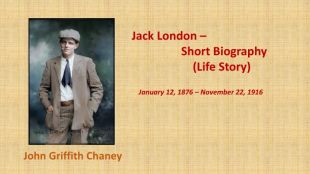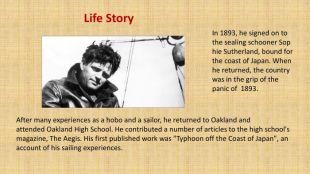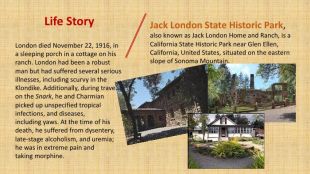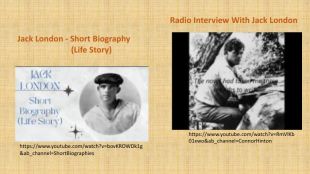Jack London. A pioneer of commercial fiction (Презентація)
















Jack London was an American novelist, journalist and activist. A pioneer of commercial fiction and American magazines, he was one of the first American authors to become an international celebrity and earn a large fortune from writing. He was also an innovator in the genre that would later become known as science fiction.
London began his writing career just as new printing technologies enabled lower-cost production of magazines. This resulted in a boom in popular magazines aimed at a wide public audience and a strong market for short fiction. In 1900, he made $2,500 in writing, about $81,000 in today's currency. Among the works he sold to magazines was a short story known as either "Diable" (1902) or "Bâtard" (1904), two editions of the same basic story. London received $141.25 for this story on May 27, 1902. Beginning of the literary career
He began to engage in literature more seriously at the age of 23, after returning from Alaska: the first "northern" stories were published in 1899, and in 1900 his first book was published - a collection of stories "Son of the Wolf". Beginning of the literary career. The writer worked very hard, 15-17 hours a day, and wrote about 40 books in his entire not very long writing life."The God of His Fathers" (Chicago, 1901), "Children of the Frost" (New York, 1902), "Faith in Man" (New York, 1904), "Moon Face" (New York , 1906), “The Lost Face” (New York, 1910), This was followed by the following collections of short stories: as well as the novels The Daughter of the Snows (1902), The Sea Wolf (1904), Martin Eden (1909), which brought the writer the widest popularity.
London's works are characterized by a special poetic language, a quick introduction of the reader into the action of his work, the principle of symmetrical narration, characterization of characters through dialogues and thoughts. Characteristic features of London’s writings. The literary style of London is expressed primarily in the desire to show a person in a difficult life situation, at the turn of fate. Realistic descriptions of circumstances are combined with the spirit of romance and adventure (the author himself defined his style as "inspired realism, imbued with faith in a person and his aspirations"). He considered R. Stevenson and R. Kipling to be his literary teachers. G. Spencer, C. Darwin, K. Marx and F. Engels had a huge influence on the writer's life philosophy; to a large extent - F. Nietzsche.
London wrote from a socialist viewpoint, which is evident in his novel The Iron Heel. Neither a theorist nor an intellectual socialist, London's socialism grew out of his life experience. As London explained in his essay, "How I Became a Socialist", his views were influenced by his experience with people at the bottom of the social pit. His optimism and individualism faded, and he vowed never to do more hard physical work than necessary. He wrote that his individualism was hammered out of him, and he was politically reborn. He often closed his letters "Yours for the Revolution."Political views
Several of London's stories would today be classified as science fiction. "The Unparalleled Invasion" describes germ warfare against China; "Goliath" is about an irresistible energy weapon; "The Shadow and the Flash" is a tale about two brothers who take different routes to achieving invisibility; "A Relic of the Pliocene" is a tall tale about an encounter of a modern-day man with a mammoth. "The Red One" is a late story from a period when London was intrigued by the theories of the psychiatrist and writer Jung*. It tells of an island tribe held in thrall by an extraterrestrial object.* Carl Gustav Jung (1875 – 1961) was a Swiss psychiatrist and psychoanalyst who founded analytical psychology.
During the journey, rich material was collected for the books The Voyage of the Snark, Tales of the South Seas, and Son of the Sun. The Snark in Australia, 1921 In 1907, the writer undertakes a round-the-world trip on the Snark ship built according to his own drawings (according to London's plan, the trip was supposed to last 7 years, but was interrupted in 1909 because of the writer's illness). By this time, thanks to high fees, London becomes a wealthy person. His fee reached 50 thousand dollars for a book, which was a very large amount. However, the writer himself was constantly short of money.
London was born near Third and Brannan Streets in San Francisco. The house burned down in the fire after the 1906 San Francisco earthquake; the California Historical Society placed a plaque at the site in 1953. London was largely self-educated. In 1889, London began working 12 to 18 hours a day at Hickmott's Cannery. Seeking a way out, he borrowed money from his foster mother Virginia Prentiss, bought the sloop Razzle-Dazzle from an oyster pirate named French Frank, and became an oyster pirate. In his memoir he claims also to have stolen French Frank's mistress Mamie. After a few months, his sloop became damaged beyond repair. London hired on as a member of the California Fish Patrol. Life Story. Life Story
In 1893, he signed on to the sealing schooner Sophie Sutherland, bound for the coast of Japan. When he returned, the country was in the grip of the panic of 1893. After many experiences as a hobo and a sailor, he returned to Oakland and attended Oakland High School. He contributed a number of articles to the high school's magazine, The Aegis. His first published work was "Typhoon off the Coast of Japan", an account of his sailing experiences. Life Story
In 1897 and 1898, London, like many other American and Canadian men, went north to Alaska and the Klondike region of Canada to search for gold. This was the Alaska Gold Rush. Although London never found any gold, his experience in the extreme environment of this cold part of the world gave him ideas for the stories he would write when he decided to return to California. Life Story
London's first marriage (1900) was to Bess Maddern, with whom he had two daughters, Joan and Bess. In choosing her, he followed the precept in a book he co-wrote with Anna Strunsky, The Kempton-Wace Letters, that mates should be selected for good breeding, not love. (Bess agreed.) Following an affair with "New Woman" Charmian Kittredge, five years his senior, he divorced Bess. In 1905 he married his "Mate Woman," who became the persona for many of his female characters and who avidly joined him on his many travel ventures. He encouraged her own writing career, and she wrote three books concerning their life (The Log of the Snark, Our Hawaii, and The Book of Jack London). Life Story
London died November 22, 1916, in a sleeping porch in a cottage on his ranch. London had been a robust man but had suffered several serious illnesses, including scurvy in the Klondike. Additionally, during travels on the Snark, he and Charmian picked up unspecified tropical infections, and diseases, including yaws. At the time of his death, he suffered from dysentery, late-stage alcoholism, and uremia; he was in extreme pain and taking morphine. Jack London State Historic Park, also known as Jack London Home and Ranch, is a California State Historic Park near Glen Ellen, California, United States, situated on the eastern slope of Sonoma Mountain. Life Story
Why is Jack London considered to be a pioneer of commercial fiction?How old was J. London at the beginning of his literary career?What were the main themes of his first short stories?How did J. London himself define his style? What were the political views of J. London?What stories written by J. London can be classified as science fiction?Questions for discussion


про публікацію авторської розробки
Додати розробку
















